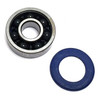Ceramic Bearings; Worth The Cost?
19th Feb 2025
Components utilizing ceramic bearings are often significantly more expensive than those utilizing alloy bearings. So is the upgrade worth it? Is it all hype? Can they really make you faster?
The short answer is perhaps, a bit, quality ceramic bearings do offer a performance increase over their all metal colleagues. They simply roll smoother and with less friction thus creating less rolling resistance. "Faster" is relative though; they will not knock 10 minutes off your next Ironman but they may get you across the finish line seconds faster, or tenths of a second faster, in your next time trial. Most manufacturers purport a 1-3% watt savings and that is significant if you are a highly competitive athlete. It is important to note that these statistics are often created in lab conditions, not real world, and are probably much lower on the road. The same watt savings can likely be gained by simply cleaning a dirty drive train or addressing minor aerodynamic changes. For some it is easier to put down their card in the hope of a bit more speed, but if you are budget conscious there are far better places to spend your money. Make sure you address the most simple/easy solutions first such as worn or dirty components. Another advantage of ceramic bearings is that they wear longer but there is another caveat and that is maintenance. Sealed cartridge bearings generally are replaced and disposed of, not maintained. But ceramic bearings can suffer the same abuse from road conditions such as riding in dry, dusty conditions. A dirty ceramic bearing with little grease is unlikely to perform much (or any) better. Maintaining them requires cleaning and degreasing each ceramic ball and then regreasing using the appropriate grease or lube.
The quality of ceramic bearings matters significantly. They must be perfectly round as they are much, much harder than steel bearings. If they are even slightly out of round a ceramic bearing will eat into the bearing races actually accelerating wear and friction. The watt savings and component longevity is highly depending on quality and a high quality bearing takes several days to make. Brands such as Ceramicspeed charge a premium for their products but they can back up their quality. If you come across a great deal on an off brand ceramics bearing upgrade it is most likely not worth the money.
What about integrating ceramic bearings throughout your bike? Cumulatively pulley wheels, bottom bracket, and wheel bearings offer greater watt savings than just pulley wheels alone, but again the cost is significant. I would not recommend the cost of upgrading a headset to ceramic as there is no performance upgrade; stick to the parts that are moving the most- wheel bearings, bottom bracket, and pulley wheels (in that order). You have to weigh the value of that small watt savings, but for those that want a slight advantage in their next race, and are willing to pay for it, ceramic bearings will edge you just a bit closer to the finish line.


